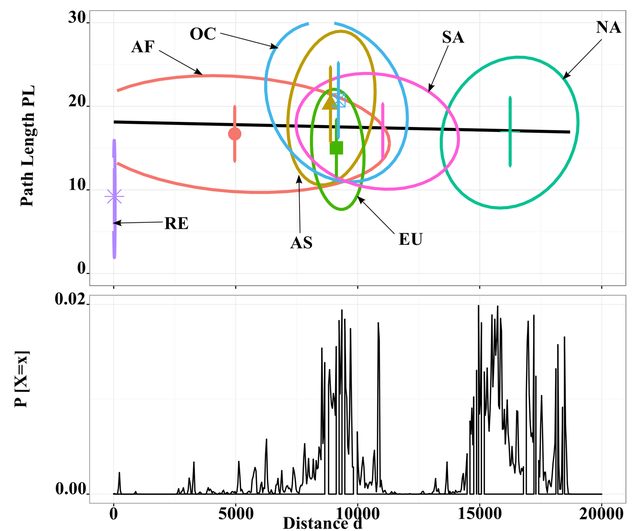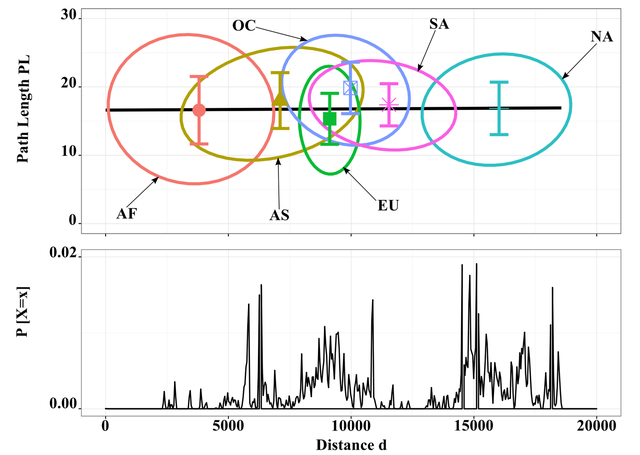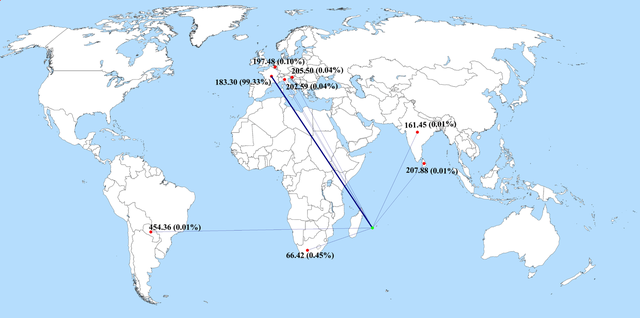Internet connectivity is not fairly distributed around the world, in particular for islands or isolated areas. For instance, connectivity to and from the Reunion Island is mainly based on links to France located about 10,000 km away. This causes long delays and degraded Internet service. In this article, we investigate the performance of the Internet connectivity by analysing delay and path properties from and to La Reunion.
Introduction
There are still geographic regions with poor Internet connectivity. Sometimes there is only a single cable connecting it to the rest of the world, which increases the risk of outages and congestion. Our research investigated the main causes of delays in such areas. In this particular case, we focus on the situation on Reunion Island. Among the known latency factors [here the term latency refers to Round Trip Time (RTT)] we focus on the geographic distance and path properties. We collected a total of 7,860,000 traceroutes through two measurement campaigns to study the routes from and towards Reunion Island.
The analysis of Internet routes from and towards Reunion Island revealed high path distortion, i.e. routing policies are far from using the shortest physical path available as 99% of the traffic is routed through a country that is 10,000 km away. We show evidence that more efficient paths exist but they are rarely used. We also studied the delay as a function of the geographic distance. Our most interesting finding is that routing policies have such high impact that the delay is inversely proportional to the geographic distance between the source and the destination.

Figure 1: Two cables connect Reunion Island to the Internet (The SAFE cable spans from Asia (India and Malaysia) to South Africa. The LION and LION 2 cables connect the lower part of the Indian Ocean to a range of submarine cables in East Africa.)
Most of the residents of Reunion Island experience slow Internet connection with frequent outages. In 2012, P. Anelli (Des aléas de la communication: de la transmission au transport. Habilitation à diriger des recherches en informatique, Université de La Réunion) compared the Internet latency observed from Reunion Island and Paris. Figure 2 shows the probability density function (PDF) of the RTT. The RTT was evaluated using the ping command on a sample of IPv4 addresses distributed over the world. The two curves show the same trend, but with a 200 ms shift. This latency difference suggests that Reunion Island traffic is tunnelled or routed towards exit points that add 200 ms to the RTT.

Figure 2: Comparison between Paris and Reunion Island
Methodology
We chose to study the Internet connectivity of Reunion Island according to the delay and the network paths. To do so we collected traceroute traces between Reunion Island and 10,000 destinations distributed worldwide. As the Internet routes are known to be asymmetric, we also performed traceroutes executed from worldwide distributed RIPE Atlas probes towards destinations located in Reunion Island.
From Reunion Island
Our active measurements made from Reunion Island used 27 Raspberry Pi probes distributed over five local ISPs (13 hosted at Orange, four at SFR, five at ZEOP, two at RENATER, and three at CanalBox). Our traces includes measurements performed from 3 July 2016 to 3 August 2016. We created a random set of 1,000,000 public IPv4 addresses. Of those only 83,850 responded to ICMP Echo requests.
Towards Reunion Island
For our experiment, we selected 1,000 RIPE Atlas probes. This selection was made so as to keep the same geographic distribution as the previous experiment (see Table 1, column 3). The RIPE Atlas probes reached ten of our Raspberry Pis deployed over Reunion Island. This set of Raspberry Pis covers all local ISPs. After sanitisation the data set came to 1,053,894 traceroutes.
| From | Towards | |
|---|---|---|
| Probes | Rasberry Pis | RIPE Atlas |
| Destination | 10,000 IP addresses | 10 Rasberry Pis |
| Sources | 27 Rasberry Pis | 1,000 RIPE Atlas probes |
| Tool | Paris-traceroute | Paris-traceroute |
| Raw Data | 7,560,000 | 300,000 |
| Sanitised Data | 1,015,180 | 38,714 |
Table 1: Summary of the data-set characteristics
Results
This section analyses the collected data and shows the characteristics of Internet connectivity in Reunion Island through delay and path properties. The accuracy of the results is dependent on the results of the geolocation of the IP addresses.
Path length and geographical distance
In our data set we found a mean path length of 17.11 hops which is close to 15.57 hops, the mean value for the whole Internet (described in J. Leguay, M. Latapy, T. Friedman, and K. Salamatian. Describing and simulating internet routes. CoRR, cs.NI/0411051, 2004). A much more interesting behaviour is that we found no correlation between the geographical distance and the path length. Figures 2 and 3 below plot the distribution of the path length as function of the distance to the end hosts.The area drawn by the ellipses contain 95% of the samples that belong to a given continent. The error bars represent the mean and standard deviation of the path length for each continent. The figures show that the path does not increase with geographical distance and that the geographical distance does not affect the path length.


Figure 3: Geographical distance and path length towards Reunion Island
Impact of path length on Round Trip Time
Figures 4 and 5 plot the distribution of the RTT as a function of the path length as well as the median and the density functions. It also plots the probability density function of the path length. The figures show that for each added node, the delay increases.

Figure 4: Dependence of the RTT and the path length (from Reunion)

Figure 5: Dependence of the RTT and the path length (towards Reunion)
Path analysis
From our traces, we extracted the country of the first router on the path located outside Reunion Island. The results are shown in Figure 6. The width of the link is proportional to the percentage of the samples that go through this country. While a direct path to the Asian continent exists, zero percent of the traffic destined to this country goes through this direct path. Most of it is routed through France. The same observation holds for East and West Africa.

In Figure 7, we show the country of the last router not located in Reunion Island for the destination located in Reunion Island with sources distributed worldwide. Similar to the previous case, the major part of the traffic is coming from France. We can see that a very small fraction of the traffic destined to Reunion Island goes through the direct path from the Asian continent or South Africa.

Figure 7: Internet paths towards Reunion Island
Conclusion
Studying path and delay is a very important task in regions where Internet access is degraded. Our evaluation shows that there is no correlation between path length and geographical distance. Especially our results concerning the dependency of geographical distance on delay were interesting, because they go against previously obtained results. In the case of Reunion Island, the delay decreases relative to geographical distance. We have investigated the last (rest. first) node before (resp. after) Reunion Island. The fact that there is a favourite path through the European continent, and more precisely through France with a minimal delay of 182,06 ms, reduces the number of possibilities to find the shortest path to the final destination.
The second step of our research about connectivity in the Indian Ocean is the deployment of probes on different islands and to further compare the situation. In future research we will look at other countries with Internet connectivity similar to Reunion Island.
For more details, please refer to the full paper Analysis of Internet Latency : the Reunion Island Case.


Comments 0
The comments section is closed for articles published more than a year ago. If you'd like to inform us of any issues, please contact us.